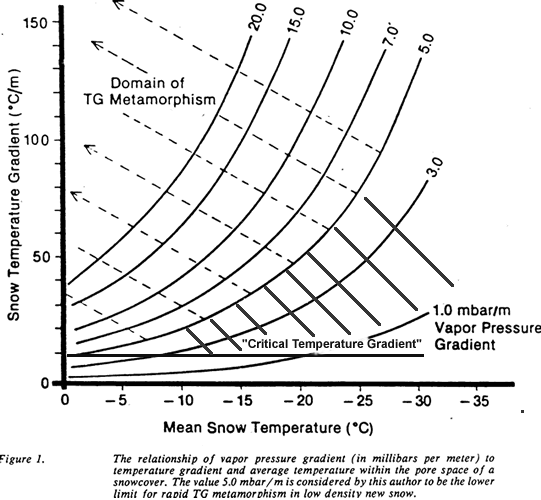Archived Article - Avalanche Education and Science Blog
<- Back to article list in simple html
Commenting: When an article is new commenting is possible in the blog (but not here in the archived versions), even without making an account or logging in. This does result in a lot of junk so after a while we disable comments. You can always email comments to us with the date/title and we will add them. We can do that anonymously, comment approval is based on merit and civility only.
Feb 27, 2007: The "Critical Temperature Gradient" Myth
For years the figure of 1°C per 10cm of depth has been called a "critical temperature gradient" and considered the gradient in the snowpack at which faceting of the grains begins. In a recent forum topic the original question was what is most important for faceting and of course this number was presented right away.
What is actually important is the vapor pressure gradient. Depending on the temperature the gradient may need to be larger (or smaller) than this "critical value" before faceting actually begins to occur.
When the vapor pressure gradient is large enough then vapor diffuses from higher concentrations to lower concentrations and faceting occurs. (This diffusion process can even be modeled by Ficks Law for a first approximation.)
Temperature gradient is an indicator of vapor pressure gradient, and something we can measure. But the amount of vapor available also depends on the actual temperature. (It may also depend on other things which I'll call second-order effects and leave it at that.) At colder temperatures there is less vapor and the same temperature gradient will have less effect.
Here is a chart showing this. I'm not sure where it originated, I scanned it out of some very old notes from a friend who took a course a long time ago. The critical gradient line and the solid diagonals have been added to the original. It shows that a larger temperature gradient can still be insufficient for faceting, and actually is in many cases.
The area where I have added solid diagonal lines is all greater than this "critical temperature gradient" but not have enough of a vapor pressure gradient for faceting.

Unfortunately I've seen professionals who teach advanced courses and even claim to have technical consulting abilities spout this critical value as soon as the issue comes up. And while I supported the original Level 1 guidelines by the AAA for the most part, I was disturbed to find the "critical temperature gradient" listed.
This is certainly not something high on the list of important factors for making "here and now" decisions on what to do. The gradient can be an indicator of whether faceting is occurring and therefore what you might find tomorrow or the next day. But on one hand, it's not as simple as a critical value. And on the other hand just knowing the weather without measuring a gradient is often sufficient to know that faceting is likely.


